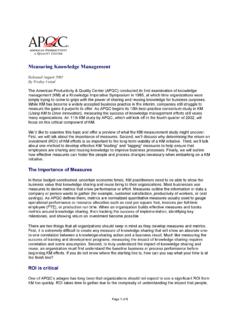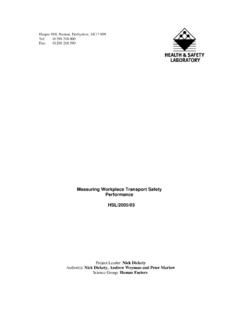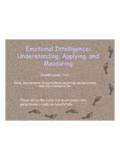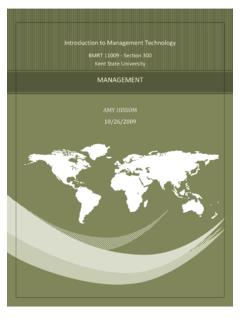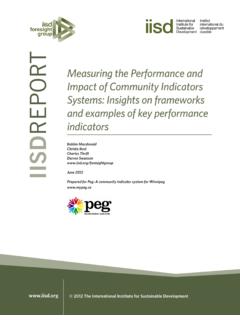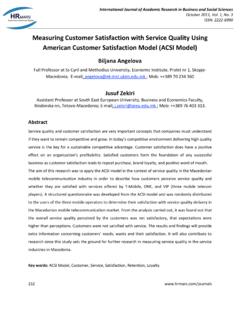Transcription of Measuring Performance, Guide to Evaluation …
1 Measuring performance A Station Manager s Guide to Evaluating Major Gifts Officers How can station managers determine if their major gifts personnel are performing at peak levels, and if the investment in these accomplished, often highly-paid development professionals, is providing an adequate return? Richard K. Dupree Executive Director of Development Kelley School of Business, Indiana University Partner, Kent E. Dove & Associates Major gifts by their very nature are negotiated carefully, and consummated slowly - often as the result of years of strategy, cultivation and care. Typically, prospects are cautious and interested in every aspect of their commitments, often adding even further delay to the final gift agreement. So how can a station manager of a major gifts officer(s) determine, especially in the early years of that development professional s tenure on staff (when gift income is usually sparse), if he/she is performing adequately? Inevitably, the major gifts officer s value is proportionate to the amount of gift income he/she secures for the station.
2 But how much time should management allow for the major gifts officer to identify and become well-acquainted with the station s listenership, become trusted as a reliable and compelling representative of the station and/or its academic raise money? If major gifts are the harvested yield of carefully sewn and tended fields, then the performance and overall value of individual major gifts officers can and should be judged on a small but critical variety of indices, and not simply left to chance or the hope of an accidental windfall of gift income. In essence, the value of major gifts officers is not just the harvested yield each year, but the quality of the seed, how effectively it s been sewn, the care and expedience with which the individuals tend their fields, and surely their inherent talents as farmers. Weather and disease still weigh in, of course, but much less if the spade work has been done! The following four simple indices serve as an indispensable tool for the effective quantification of major gifts officers regardless of their length of tenure on staff.
3 These indices were prepared by major gifts officers for major gifts officers, and have been refined and distilled over the years to provide a remarkably potent snapshot of progress at any point throughout the fiscal year. Managers no longer have to rely on speculation. Each index is graded on a 25-point scale and illustrates where the major gifts officer might be behind in terms of his/her overall performance (more on that later). Simply stated, this is where the rubber meets the road .. 1. Dollar Goal The least important of the four indices. Often major gifts officers focus exclusively on dollars raised and devote their complete attention to two or three of their finest prospects in hopes of capturing the mega-gift , and impressing management . Make no mistake, mega-gifts are wonderful (and do impress management ), but that tack is risky and does not serve the major gifts officer or management well in this system. It s a fool s bet, especially in the early years of a major gifts officer s tenure on staff.
4 The top prospects 1surely have to be carefully and strategically courted and solicited when ready, but not at the expense of the next tier, and the To safeguard against just meeting and cultivating, however, reasonable dollar goals remain necessary. Even first-year major gifts officers should be presented with a defined dollar goal of cash/cash pledges and deferred (trusts/annuities/bequests). 2. Proposals A minimum number of approved proposals should be generated each year - and at a minimum ask level. You never know if you don t ask has never been more true. The major gifts officer should write compelling proposals and, if he/she is doing his/her job effectively, will have a number of prospects at each of the major levels of readiness , some of whom will warrant proposal submission. To guard against the shotgun approach of simply generating proposals to meet quota and, in turn, harm the potential for a significant gift from a prospect, this system evaluates and grades the number of funded proposals (yeses) to no s and rewards the high grade.
5 3. Contacts Major gifts officers must make This is the seed referred to earlier. A pre-determined number of annual contacts should be established. A large percentage of them should be face-to-face with the remainder at the discretion of the individual major gifts officer. Contacts provide information, information fosters cultivation, cultivation leads to solicitation which leads to accepted proposals and funding. 4. Overall Quality of Work This is the most flexible of the indices. Surely other characteristics exclusive to the station can be substituted in place of these, but the following five have worked well in a variety of non-profit settings. Hit rate The ratios of yeses to no s in the proposals submitted. Prospecting New prospects (cold calls) are critical to maintaining the success of development efforts. The vast majority of major gifts prospects/donors began as small- to mid-range annual/membership donors. A pre-determined number of prospecting visits should be factored into the major gifts officer s goals at the beginning of the fiscal year.
6 Cultivations Major gifts officers should be assigned a pre-determined number of cultivations each year. These are visits with individuals who are not new to the major gifts officers (and vice-versa), but not presently at the readiness level to accept a proposal for a major gift. Via written tracking reports summarizing these and all prospect contacts, management determines whether or not the visit actually moved the prospect from A to B , that is, toward the inevitable goal established for that prospect. This not only safeguards against unprepared visits (bad for both the prospect and major gifts officer), but provides an 2ongoing tool by which the major gifts officer can continually learn to write concise, meaningful tracking reports. Use of management /leadership Quite often, management /leadership s participation in an ask is useful and should be encouraged. It sends the message to the prospect that the visit and ask is important, if not critical, to the well-being of the station.
7 A well-prepared major gifts officer plans his/her year to know when, for the most part, management and/or leadership will be useful. This not only serves as a reminder to have the prospect and management well-prepared ahead of time, but also affords the major gifts officer the opportunity to book time on what are undoubtedly busy management calendars. Budget management Inevitably, there are entertainment and, in some cases, travel costs associated with major gifts fundraising. Major gifts officers should be given a budget with which to work and plan accordingly at the beginning of the year as to how and when that budget will be expended. Hosting meals, outings, phone/cell charges, etc should be estimated and factored into the budget at the outset to safeguard against incurring expenses that might not be necessary or a good investment of institutional resources. Evaluating the Success (The Tool) Successful major gifts officers are active, creative entrepreneurs. They prefer well-defined goals and the autonomy to meet and exceed them.
8 This simple, yet effective, system is based on a possible 100 points, in which an annual score of 80 or greater would illustrate above-standard performance and warrant an incentive bonus. Prior to the beginning of each fiscal year, the major gifts officer, in consult with management , should be assigned quantitative goals in each of the four areas dollars raised; major gift proposals submitted; bonifide contacts made with approved, written tracking reports submitted; and the overall quality of work, based on five indices, equally weighted (5 points@): Points Dollar goal (cash and pledges) 25 Proposals submitted 25 Contacts 25 Quality of work 25 A. Hit rate 5 B. Prospecting 5 C. Cultivations 5 E. Use of management /leadership 5 F. Budget management 5 100 3 Minimum Expectations The major gifts officer must earn no fewer than 75 points each cycle to register a satisfactory year, but receive no incentive reward.
9 The major gifts officer must earn no fewer than 80 points each cycle to warrant the incentive bonus. For instance: John Q. Smith Director of Development, Major Gifts As of June 30, 2004 PointsGoalActual Points Earned Dollar goal (cash and pledges)1 25 $1m $500k Proposals submitted2 25 30 35 25 Contacts3 25 150 167 25 Quality of work4 25 - - 16 A. Hit rate 3 B. Prospecting 2 C. Cultivations 4 E. Use of management /leadership 2 F. Budget management 5 100 More than 75, less than ( satisfactory , but no bonus offered) 1 The 1,000,000 goal is defined as 50% cash or pledges and 50% deferred commitments. All must include documentation (signed pledge card, signed Gift Agreement, codicil of Will, or fully executed trust) to be applied against the goal. 2 Written proposal must be on file and no more that 20% (6) of proposals can request less than $75,000.
10 3 The 150-contact goal is defined as 50% face-to-face with the remainder via face-to-face, phone, e-mail, event, or other approved mode of contact. All contacts must be of the quality to move prospects from A to B as determined by the management in order to apply against the goal 4 Sections A-E are detailed in the updated Evaluation and Incentive system document. Section E is based on a $10,000 FY05 travel budget which includes all phone and travel and entertainment costs with the exception of special travel requests by the management . Quantitative review John did a fine job in his proposals submission, and received 25 of a possible 25 points. His contacts were well over the 150-contact goal established that year. He earned another 25 points. It appears that his hit rate (yeses to no s in response to his proposals) was around 60%, earning him 3 of a possible 5 points. He only successfully prospected and cultivated 40% and 80%, respectively, of what was asked of him.
